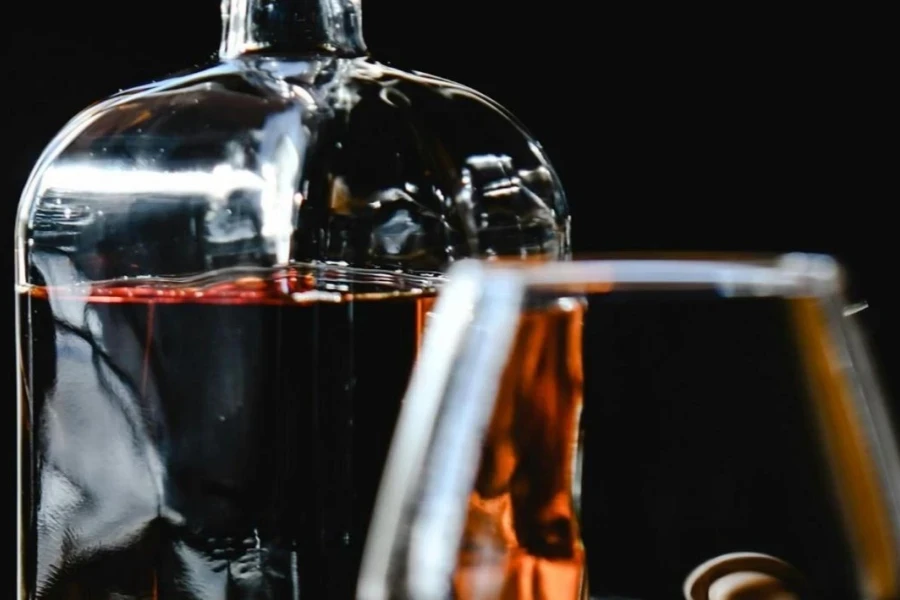Many see decanters as exclusive items for wine snobs or sommeliers. But the truth is that every wine drinker (expert or novice) needs decanters in their arsenal. However, their classic look can easily intimidate most retailers.
But don’t worry. This guide will help businesses understand everything they need to know when choosing decanters to sell to wine enthusiasts.
Table of Contents
A brief look at the global decanter market
What are decanters, and why are consumers looking for them?
4 important aspects to consider when choosing decanters
Bottom line
A brief look at the global decanter market
The decanter market is currently valued at US$385.82 million and will become even more valuable by the end of 2024. Experts say the global decanter market will grow to US$510.01 million by FY 2031 at a 3.55% compound annual growth rate (CAGR). The market’s drivers include rising popularity, increased wine consumption, and a surging home entertainment trend.
More importantly, glass decanters registered the highest market share in 2022 due to aesthetics, ease of cleaning, versatility, transparency, and other benefits. Europe also emerged as the highest revenue generator in 2022 due to the region’s high wine consumption.
What are decanters, and why are consumers looking for them?

Sometimes, consumers need to aerate their wine and spirits before drinking. That’s where decanters come in. These glass or crystal containers have designs that help the wine breathe. The result? Better flavors and aromas!
Moreover, red wines are the most popular drinks consumers use with decanters. Since they have denser and more tannic tastes, decanters can help soften them for a better experience. In addition to enjoying new aromas and flavors, decanters make these drinks less bitter.
But that’s not all. Consumers also need decanters to remove sediments from their drinks, stopping them from affecting the aroma/taste and harming the user. So, how many people are searching for decanters in 2024?
According to Google data, decanters attracted 165,000 searches in July 2024. Based on this data, they have an impressive search volume, meaning people still want them in 2024. Keep reading to learn how to choose the perfect decanter to sell.
4 important aspects to consider when choosing decanters
1. Size

Decanter size determines how much wine consumers can aerate. Due to their limited space, each size handles different wine types better. Here’s a table with more information.
| Decanter size | Description | Wine type |
| Small wine decanters | Consumers can easily use these decanters to aerate one glass of wine or two. | ● Lighter-bodied or small-bodied red wines ● White or rose wines |
| Medium wine decanters | These are the standard sizes. Consumers can use them to decant up to one bottle of wine or spirits. | ● Medium-bodied red wines |
| Large wine decanters | Large decanters appeal to consumers hoping to aerate more than one bottle. Some wines, especially those in the 1 to 1.5-liter range, aerate faster in large decanters. | ● Full-bodied wine ● Younger wines |
2. Shape

Retailers can also offer wine enthusiasts different decanter shapes. That way, consumers can choose the perfect one that matches their wine’s surface area needs. Here’s a closer look at the different decanter shapes:
U-shaped/swan wine decanter
U-shaped decanters are strikingly different from traditional designs. As their name implies, they have designs resembling a “U” or horseshoe. Beyond their aesthetic appeal, these decanters have practical uses.
They have two spouts (one narrow and one wide), one of which allows consumers to grip and pour their decanted wine into a glass. Even better, buyers can use both ends as a spout and handle.
Additionally, U-shaped decanters offer various designs, from modern and sleek to ornate and intricate. Typically, consumers use these decanters for mature wines requiring less aeration. They are also perfect for gentle pouring and minimal sediment disturbance.
Wide-bottom decanters
These decanters have been getting much attention lately because of their unique features. Why is this shape so particular? It is wider at the bottom and narrower at the top, increasing the drink’s surface area and allowing for enhanced aeration.
The results are significantly better wine and spirit aromas and flavors. Plus, they have an elegant silhouette that makes decanting wine look amazing. Wide-bottom decanters are the go-to for young, bold red wines.
Long-necked decanters
Consumers can go for long-necked decanters when they want the perfect blend of elegance and practicality. Their distinctive long necks may look graceful, but it’s not all about looks. This shape is also efficient.
The long neck and slimmer body are perfect for holding the delicate aromas of older wines. Long-necked decanters also control pouring, allowing users to release their wine’s flavors gradually. For this reason, consumers prefer these decanters for mature red and complex white wines.
Snail-shaped wine decanters
Snail-shape decanters are a unique version of wide-based decanters. Their snail-like appearance comes from a middle opening, which gives them a fantastic grip when pouring a drink.
3. Type

Similar to designs, retailers can offer different decanter types for various preferences. Some consumers prefer the standard way, while others want to take a drink immediately. Thankfully, there’s a type for every decanting style.
Standard wine decanters
These are the classic decanters. They have functional and aesthetically pleasing designs, featuring wide bases and tapered necks for aeration. Standard wine decanters are versatile, meaning consumers can use them for different wines and spirits.
On the aesthetic side, standard wine decanters can make any table setting feel more sophisticated. They are a great way to balance form and function, allowing consumers to enhance the wine and dining experience.
Wine decanter with strainer
As previously mentioned, some wines contain sediments that are not good for taste or the drinker’s health. However, some decanters have attached strainers on their spouts to help with this issue. They offer an extra filtering layer that separates sediment from clear liquid, making them great for aged wine.
Electric decanters
While many appreciate the slow decanting process, some consumers don’t want to wait that long for a drink. Electric decanters allow them to enjoy faster aeration and have mobile apps so that consumers can control the process from their phones.
4. Material

Manufacturers make most decanters from glass. However, the more premium options feature crystal glass. Sadly, other materials (like stainless steel and plastic) will affect the wine’s taste during aeration. Check out the differences between glass and crystal decanters below:
Standard glass decanters
Glass decanters are famous for their thicker walls and classic, simple shapes. However, retailers must target suppliers offering decanters made from borosilicate glass if they want to provide the best experience. Compared to other types, borosilicate glass has high thermal shock resistance and is dishwasher safe.
Crystal decanters
On the other hand, crystal decanters are high-quality and incredibly durable. They are usually bigger and more artistic than standard glass decanters.
However, some crystal decanters may contain lead. But the amount is small enough to be dangerous, especially if consumers don’t leave their drinks in these decanters for long. Nevertheless, it’s better to use lead-free crystal decanters for maximum safety.
Bottom line
Wine decanters have evolved from ordinary vessels to tools for transforming wine and spirits into memorable experiences. Whether consumers host sultry dinner parties or enjoy an evening alone, decanters can help elevate their experience, enriching flavors, aromas, and overall enjoyment.
Ready to enter the world of wine and spirits decanters? These products already have a high search volume, and businesses can leverage it by following this guide.




